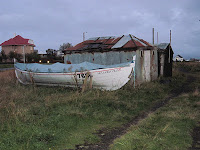 |
Desert Camel by Sherbaz Jamaldini
from Wikimedia Commons |
When I tell students about Old Norse poetry and try to explain how kennings work, I turn to that old chestnut, the 'ship of the desert', though recently I have noticed that students respond with a slightly puzzled look to what I thought was a well-known expression. But I plough on, explaining that it's rather a good kenning because we all know that what characterises the desert is that it is drier than anywhere else on the planet, and so the last place you would expect to find a ship. But if you start thinking about it, the sand dunes are not unlike waves and the camel is after all a mode of transport. So, we start by imagining a ship (the base word), but then the addition of the word 'desert' (the determinant) turns our thoughts to sand dunes, rocking motions and transport, and we eventually arrive at the correct solution, which is 'camel'.
The other reason this is a useful example is that it is in many ways the exact opposite of that very common Old Norse kenning, the 'horse of the sea'. Horses can't travel on water, but they are a sturdy and trusty mode of transport on land, over the hills and heaths, just like your Viking ship is on the ocean. Thus, both the camel-kenning and the ship-kenning conform to the definition offered by Margaret Clunies Ross in
A History of Old Norse Poetry and Poetics (2005, pp. 107-8):
... a noun phrase comprising two nouns in a genitival relationship (or a compound noun with an implicit genitival relationship between two distinct elements) ... used ... as a substitute for a noun referent. ... the three essential elements of the kenning [are] the base word, the determinant, which is usually in the genitive case or implicitly so, and the referent, which is unnamed.
I shall leave aside the complexities of how kennings really work in Old Norse poetry, and how they might have been understood by the Old Norse poets, and the medieval scholars who wrote about them, as much has been written on this and it is all a bit heavy for this light-hearted blog. Rather, I wanted to speculate a bit on modern kennings.
Now modern poetry inspired by or imitative of Old Norse poetry often makes use of kennings and kenning-like constructions, as you can see for example on the excellent
Kennings in the Community website. But these are all made by people with at least some acquaintance with the Old Norse tradition and, in their quest to write good modern poetry, they do not always conform to the relatively strict definition cited above.
I'm more interested in kennings that are used less knowingly, in the poetry of the everyday, as in the Icelandic mousetrap
I once blogged about. So when I come across something that seems suitable I make a note, and now have a small collection, which I am always eager to expand. My students sometimes come up with kennings, some of which are unprintable in a family blog. One clever student reminded me that both 'sea-lion' and 'hippopotamus' are kennings. Indeed the latter appears as a 'water-horse' or words to that effect in some languages (cf. Hungarian 'viziló'), though I am not very clear where the 'horse' idea comes into it, and it's a very different animal from the 'horse of the sea' I mentioned above.
The Old Norse 'horse of the sea' is popular in modern times,
as I pointed out when this blog was still in its infancy, as 'steed of the waves' on Robert Calvert's 1975 album
Lucky Leif and the Longships. But perhaps that is all a bit obvious - so what else is out there? My trusty notebook offers the following:
Observing tree surgeons working round about the place, I notice that they often use a machine called the Timberwolf to mash up the wood after they have properly pruned the branches.
On a natural history programme on the radio I heard about a North American salamander that is known as a 'snot-otter' (which has a bit of skaldic internal rhyme, too). This is apparently because it excretes mucus when you pick it up and it lives in rivers. Charming.
In the Observer magazine, I saw a photographic feature on a well-known fashion model that eschewed the word 'bra' and spoke instead of her 'tit-pants'.
Better known kennings include phrases like 'couch potato' and the similar 'porch monkey' I found on
www.urbandictionary.com. Doubtless there are more to be found there if I could be bothered to search, but I prefer the surprise of serendipity.
All of these thoughts were sparked off by
a letter in today's Guardian. In a series of recent letters about seagulls, one Glyn Reed wrote in to inform us that:
In the Royal Navy in the late 70s, any and all seagull-type birds were collectively known as “shitehawks”.
I guess this only
really works if hawks don't normally defecate, or at least do so less than seagulls...who knows?
Of course these are all simple two-element kennings, such as you also find in Old English with its swan-roads and whatnot. To really understand the glory of kennings, you do have to study Old Norse poetry, firstly to find how many ways simple phrases like 'horse of the sea' can be varied, and secondly to discover the baroque delights of three-(or more)element kennings and kennings within kennings.


















.jpg)
.jpg)













